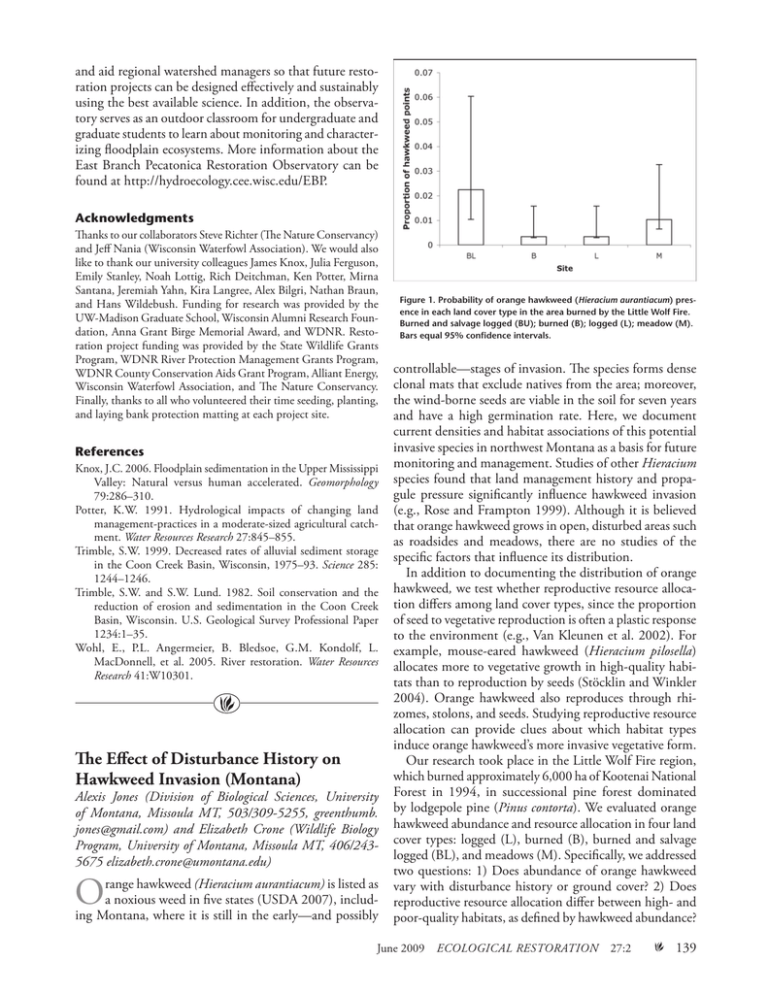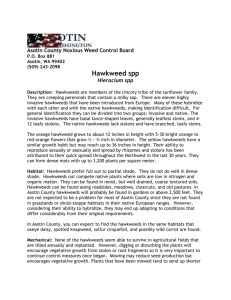and aid regional watershed managers so that future resto-
advertisement

and aid regional watershed managers so that future restoration projects can be designed effectively and sustainably using the best available science. In addition, the observatory serves as an outdoor classroom for undergraduate and graduate students to learn about monitoring and characterizing floodplain ecosystems. More information about the East Branch Pecatonica Restoration Observatory can be found at http://hydroecology.cee.wisc.edu/EBP. Acknowledgments Thanks to our collaborators Steve Richter (The Nature Conservancy) and Jeff Nania (Wisconsin Waterfowl Association). We would also like to thank our university colleagues James Knox, Julia Ferguson, Emily Stanley, Noah Lottig, Rich Deitchman, Ken Potter, Mirna Santana, Jeremiah Yahn, Kira Langree, Alex Bilgri, Nathan Braun, and Hans Wildebush. Funding for research was provided by the UW-Madison Graduate School, Wisconsin Alumni Research Foundation, Anna Grant Birge Memorial Award, and WDNR. Restoration project funding was provided by the State Wildlife Grants Program, WDNR River Protection Management Grants Program, WDNR County Conservation Aids Grant Program, Alliant Energy, Wisconsin Waterfowl Association, and The Nature Conservancy. Finally, thanks to all who volunteered their time seeding, planting, and laying bank protection matting at each project site. References Knox, J.C. 2006. Floodplain sedimentation in the Upper Mississippi Valley: Natural versus human accelerated. Geomorphology 79:286–310. Potter, K.W. 1991. Hydrological impacts of changing land management-practices in a moderate-sized agricultural catchment. Water Resources Research 27:845–855. Trimble, S.W. 1999. Decreased rates of alluvial sediment storage in the Coon Creek Basin, Wisconsin, 1975–93. Science 285: 1244–1246. Trimble, S.W. and S.W. Lund. 1982. Soil conservation and the reduction of erosion and sedimentation in the Coon Creek Basin, Wisconsin. U.S. Geological Survey Professional Paper 1234:1–35. Wohl, E., P.L. Angermeier, B. Bledsoe, G.M. Kondolf, L. MacDonnell, et al. 2005. River restoration. Water Resources Research 41:W10301. The Effect of Disturbance History on Hawkweed Invasion (Montana) Alexis Jones (Division of Biological Sciences, University of Montana, Missoula MT, 503/309-5255, greenthumb. jones@gmail.com) and Elizabeth Crone (Wildlife Biology Program, University of Montana, Missoula MT, 406/2435675 elizabeth.crone@umontana.edu) O range hawkweed (Hieracium aurantiacum) is listed as a noxious weed in five states (USDA 2007), including Montana, where it is still in the early—and possibly Figure 1. Probability of orange hawkweed (Hieracium aurantiacum) presence in each land cover type in the area burned by the Little Wolf Fire. Burned and salvage logged (BU); burned (B); logged (L); meadow (M). Bars equal 95% confidence intervals. controllable—stages of invasion. The species forms dense clonal mats that exclude natives from the area; moreover, the wind-borne seeds are viable in the soil for seven years and have a high germination rate. Here, we document current densities and habitat associations of this potential invasive species in northwest Montana as a basis for future monitoring and management. Studies of other Hieracium species found that land management history and propagule pressure significantly influence hawkweed invasion (e.g., Rose and Frampton 1999). Although it is believed that orange hawkweed grows in open, disturbed areas such as roadsides and meadows, there are no studies of the specific factors that influence its distribution. In addition to documenting the distribution of orange hawkweed, we test whether reproductive resource allocation differs among land cover types, since the proportion of seed to vegetative reproduction is often a plastic response to the environment (e.g., Van Kleunen et al. 2002). For example, mouse-eared hawkweed (Hieracium pilosella) allocates more to vegetative growth in high-quality habitats than to reproduction by seeds (Stöcklin and Winkler 2004). Orange hawkweed also reproduces through rhizomes, stolons, and seeds. Studying reproductive resource allocation can provide clues about which habitat types induce orange hawkweed’s more invasive vegetative form. Our research took place in the Little Wolf Fire region, which burned approximately 6,000 ha of Kootenai National Forest in 1994, in successional pine forest dominated by lodgepole pine (Pinus contorta). We evaluated orange hawkweed abundance and resource allocation in four land cover types: logged (L), burned (B), burned and salvage logged (BL), and meadows (M). Specifically, we addressed two questions: 1) Does abundance of orange hawkweed vary with disturbance history or ground cover? 2) Does reproductive resource allocation differ between high- and poor-quality habitats, as defined by hawkweed abundance? June 2009 ECOLOGICAL RESTORATION 27:2 139 Figure 2. Allometric relationship between natural log of orange hawkweed (Hieracium aurantiacum) vegetative and reproductive mass. Comparison is between plants in burned-and-logged sites and the other three site types (meadow, logged, and burned) in the Little Wolf Fire area. We chose individual sites after visual assessment of land cover type, but without prior knowledge of hawkweed presence. For each of the four land cover types, we selected three noncontiguous study sites 1–5 km apart. Within each site we sampled 50 stratified random plots in a 5 × 10 grid of points regularly spaced every 10 m, with plots offset randomly from each point by 0–5 m. In each of the 1-m² plots (n = 600), we recorded the presence or absence of hawkweed, collected data on overstory canopy cover using a spherical densiometer, and surveyed ground cover by visually estimating the percentage of thatch, bare ground, rocks, grass, forbs, pine needles, shrubs, dead wood, and moss. We used discriminant function analysis to test whether plot variables and land cover type were associated with orange hawkweed presence. The only significant association with land cover was a higher probability of orange hawkweed presence in burned and logged (BL) sites (p = 0.002). Out of the other three land cover types, less disturbed sites (L and B) showed marginally significantly lower probabilities of hawkweed occurrence relative to meadows (0.075 > p > 0.05; Figure 1). Three ground cover variables were significant predictors of orange hawkweed: thatch was negatively associated with presence in a site (p = 0.041), while both forbs (p < 0.001) and moss (p = 0.015) were positively associated. We compared total mass and resource allocation of plants in BL sites (high-quality sites, as defined by the highest orange hawkweed abundance) to those in the other three land cover types. We collected up to five flowering plants per site, selected randomly from plants encountered in the surveys (n = 36; 17 in BL, 11 in M, 4 in L, and 4 in B). Collected plants were washed and air-dried in the lab, then separated into reproductive (flowers and stems) and vegetative (rosettes and roots) biomass. We compared the average total mass and resource allocation among habitat types using ANOVA. In addition, we analyzed vegetative 140 June 2009 ECOLOGICAL RESTORATION versus reproductive mass using allometric relationships as indicated by the slopes of resource allocation between BL sites and the other sites. Total biomass did not differ significantly between BL and the three other habitats (B, L, and M). Vegetative and reproductive biomass had a positive allometric relationship (p = 0.055); although larger plants produced more reproductive biomass, less of their total mass was allocated to flowers. Plants in BL sites allocated proportionately fewer resources to seed production, as indicated by a lower intercept in the fecundity-vegetative biomass relationship (p = 0.075; Figure 2). Orange hawkweed appears to be genetically uniform within North America (Loomis 2007), so this response suggests phenotypic plasticity. This plasticity seems to be adaptive, with plants allocating more resources to long-distance dispersal in lower-quality environments, and more resources to vegetative spread in higher-quality environments. Our results indicate that the common perception of orange hawkweed as primarily a roadside and meadow weed of minor importance is flawed. We found that the species is actually most abundant in areas that have been burned and salvage logged—combining the best of low competition, sunlight, and disturbance, indicating that it is important to test habitat associations in new areas. This study also shows that where orange hawkweed is highly abundant, it is most problematic owing to dense mats caused by vegetative spread that may exclude other species. However, in land cover types with lower local abundance, plants produce more wind-borne seeds to spread to new sites. This makes any site where orange hawkweed exists a potential problem. Acknowledgments This research was supported by undergraduate research grants from the Montana NSF EPSCoR program, the Davidson Honors College, and USFS Rocky Mountain Research Station RJVA 04-JV11222048-180. Research was conducted while E. Crone was supported by NSF DEB 02-36427. This manuscript benefited from discussion with C. Nelson. References Loomis, E. 2007. Sex and diversity in the invasive plant Hieracium auranticaum. MS thesis. University of Montana. Rose, A.B. and C.M. Frampton. 1999. Effects of microsite characteristics on Hieracium seedling establishment in talland short-tussock grasslands, Marlborough, New Zealand. New Zealand Journal of Botany 37:107–108. Stöcklin, J. and E. Winkler. 2004. Optimum reproductive and dispersal strategies of a clonal plant in a metapopulation: A simulation study with Hieracium pilosella. Evolutionary Ecology 18:563–584. USDA, NRCS. 2007. The PLANTS Database (plants.usda.gov, 20 March 2007). National Plant Data Center, Baton Rouge, LA 70874–4490 USA. 27:2 Van Kleunen, M. Fischer and B. Schmid. 2002. Experimental life-history evolution: Selection of the allocation to sexual reproduction and its plasticity in a clonal plant. Evolution 56: 2168–2177. Reducing Grouse Collision Mortality by Marking Fences (Oklahoma) Donald H. Wolfe (G.M. Sutton Avian Research Center, University of Oklahoma, PO Box 2007, Bartlesville, OK 74005, dwolfe@ou.edu), Michael A. Patten (Oklahoma Biological Survey, University of Oklahoma, Norman, OK 73019) and Steve K. Sherrod (G.M. Sutton Avian Research Center) A number of grouse species collide frequently with power lines, overhead cables, and fences. Because grouse fly fast these collisions are often immediately fatal, but likely a considerable number of birds either succumb later to injuries or become incapacitated and more vulnerable to predation. A multiyear radio-tracking study of the lesser prairie-chicken (Tympanuchus pallidicinctus) in Oklahoma found that collisions, primarily with stock fences, were the leading cause of mortality (Wolfe et al. 2007). Several other species of grouse, including the greater sage-grouse (Centrocercus urophasianus) in North America and black grouse (Tetrao tetrix) and western capercaillie (Tetrao urogallus) in Europe, also suffer high mortality rates because of fence collisions (e.g., Catt et al. 1994). In an effort to reduce this unnatural mortality, we explored various ways of marking fences to improve their visibility. Ideal marking material would be easily affixed, inexpensive, durable, and safe for livestock, and would add little or no weight or wind resistance to fences. The lesser prairie-chicken has declined markedly in both extent of occupied range and population density. After being petitioned in 1995 under the Endangered Species Act, the U. S. Fish and Wildlife Service (USFWS) determined that protection was “warranted but precluded,” so the lesser prairie-chicken remains only a candidate for listing. In 1999, we began a long-term study of the species in northwestern Oklahoma and eastern New Mexico to determine causal factors of the decline. In the past ten years, we have captured over 900 lesser prairie-chickens on spring and (sometimes) fall leks. We radio-tagged most males and all females, using a bib-mounted, tuned, looped transmitter with a mortality signal that allows early carcass recovery. All radioed birds were tracked at least weekly until transmitter batteries expired (roughly two years) or until the bird died. For each carcass, we attempted to determine the probable cause of mortality using established criteria (Dumke and Pils 1973) and measured distance to the nearest fence, road, and power line (we estimated distances >100 m). Figure 1. Side view of fence marker cut from vinyl undersill. Photo by Donald H. Wolfe Fence collisions accounted for over 40% of the mortality (Wolfe et al. 2007). Although some carcasses lay immediately below a fence, the majority resulting from collisions were from several to 30 meters from a fence, suggesting that the bird plummeted or tumbled after impact. Much of the rangeland in northwestern Oklahoma is fenced in 65 ha (1/4 section) pastures, and because county roads usually run along every section line, there is often at least 6 linear miles of fence per square mile (3.8 linear km/km2). We concluded that fence marking could be an important conservation tool for this species. European efforts to mark fences to reduce grouse collision rates met with success, reducing collisions across species by roughly 70% (e.g., Baines and Andrew 2003). However, material used in Europe—strips of barrier (safety) fence—was both expensive and susceptible to deterioration by ultraviolet radiation. Additionally, whereas strips of barrier fence could be attached to woven wire fences, there is no practical way to attach it to barbed-wire stock fences. The vast majority of fences in our focus area are 5-strand, high-tensile, barbed-wire type, with a typical spacing of 3.7 m between fence posts. Summers and Dugan (2001) evaluated different materials used to mark fences, but the most effective are cost prohibitive if used on a large scale. We therefore experimented with a number of materials and methods, including strips of polypropylene webbing attached to fence posts running parallel to fence wires, strips of aluminum flashing suspended from one wire, and pieces of polypropylene rope wrapped from the top wire to the second wire. All of these methods were either too labor intensive, not visible enough to be effective, or not durable. Other materials and marking methods likely can be utilized, but we eventually hit upon a solution that met our criteria for cost, ease of application, durability, weight, June 2009 ECOLOGICAL RESTORATION 27:2 141




